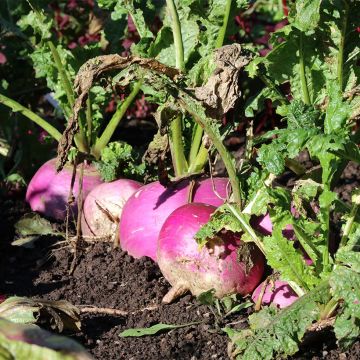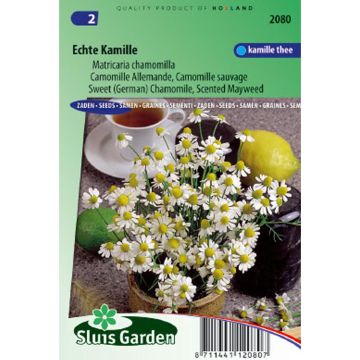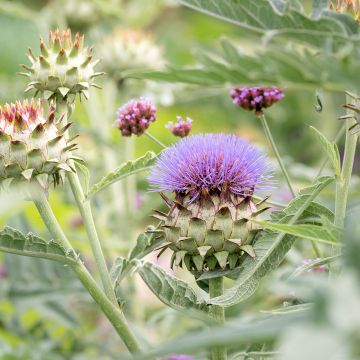

Barbarea verna - Cresson de terre ou de jardin, barbarée printanière
Barbarea verna - Land cress
Barbarea verna
Land Cress, American Cress, Bank Cress, Black Wood Cress, Belle Isle Cress, Early Yellowrocket, Early Wintercress
This item cannot be shipped to the selected country
Delivery charge from €5.90
More information
Schedule delivery date,
and select date in basket
This plant carries a 6 months recovery warranty
More information
We guarantee the quality of our plants for a full growing cycle, and will replace at our expense any plant that fails to recover under normal climatic and planting conditions.
From €5.90 for pickup delivery and €6.90 for home delivery
Express home delivery from €8.90.
Description
Barbarea verna, also known as Spring Barbarea, Ground cress or Garden cress, is a biennial plant from native European flora, similar to watercress and land cress, which can sometimes be found in fields, lawns, and stream banks, always in more or less damp areas. In the garden, this herbaceous plant can be grown in the vegetable garden, as well as in slightly wild areas where its yellow flowers are charming. Its acidic and spicy leaves enhance salads and soups. Let a few seeds form, and Spring Barbarea will self-seed in the garden or can be sown in the vegetable garden. A forgotten culinary herb, definitely worth rediscovering!
Barbarea verna belongs to the Brassicaceae family, it is a relative of rapeseed, mustard, and watercress. It is a hardy biennial herbaceous plant native to Western Europe, found from Sweden to Portugal and Italy. In the first year, the plant produces a rosette of long, thick, deeply divided leaves with shiny dark green lobes. They have a pungent and pleasant flavour, slightly stronger than that of watercress. The foliage persists throughout winter. This ground cress blooms in the second year, from April to July: it has branched flower spikes that are 50-60 cm (20-24in) tall, bearing small yellow flowers similar to those of mustard. The flowers, pollinated by insects, give way to seeds that can be collected and sown from March to August the following year. The plant dies after producing its flowers and seeds.
Harvest: the leaves should be harvested as needed. Ideally use the fresh leaves on the same day, although they can be kept for 3 days in the refrigerator, wrapped in a damp cloth.
Usage: same as watercress. Raw leaves in salads (in moderation), or to accompany poultry, or cooked in soups. The foliage can be cooked like spinach or braised in a casserole.
Garden cress is planted in the vegetable garden, in well-prepared, loosened soil enriched with compost, which remains slightly moist throughout the growth and flowering season, but not waterlogged. It can also be grown in pots and containers as long as watered regularly. Plant it in a sunny but not scorching position; in full summer, the leaves will remain tender if the plant is slightly shaded in the afternoon.
Tips:
To stagger the harvests, sow the Barbarea seeds you have collected every 15 days. Make sure to water regularly in summer if the weather is dry. If it gets very hot, protect your plants by placing overturned crates on top of them. In case of freezing temperatures, apply a mulch of dry leaves to protect the plants. Early pruning of the forming flower spikes promotes the formation of new shoots and leaves.
Report an error about the product description
Harvest
Plant habit
Foliage
Other Vegetable garden A to Z
Planting and care
Spring barbarea can be grown in loose, well-drained soil enriched with compost, which should always remain slightly moist. Water during the summer if the weather is hot and dry. Avoid planting in a hot and sunny location, as the leaves become tough and have a stronger flavour. Provide shade for your plants if necessary using overturned crates. It is a hardy plant, but the leaves can be damaged by severe frost. Protect your plants with a thick layer of mulch in case of very cold temperatures, and uncover them as soon as the temperature becomes milder. Allow some flowers to produce seeds so that you can sow them again the following year.
Sowing:
Sow directly in the ground, broadcasting the seeds or in spaced rows 25 cm (10in) apart, from March to August. Lightly cover the seeds with soil and water. Thin out the young plants when rosettes form, keeping only one plant every 25 cm (10in).
Cultivation
Care
Intended location
This item has not been reviewed yet - be the first to leave a review about it.
Old and forgotten vegetables
Haven't found what you were looking for?
Hardiness is the lowest winter temperature a plant can endure without suffering serious damage or even dying. However, hardiness is affected by location (a sheltered area, such as a patio), protection (winter cover) and soil type (hardiness is improved by well-drained soil).

Photo Sharing Terms & Conditions
In order to encourage gardeners to interact and share their experiences, Promesse de fleurs offers various media enabling content to be uploaded onto its Site - in particular via the ‘Photo sharing’ module.
The User agrees to refrain from:
- Posting any content that is illegal, prejudicial, insulting, racist, inciteful to hatred, revisionist, contrary to public decency, that infringes on privacy or on the privacy rights of third parties, in particular the publicity rights of persons and goods, intellectual property rights, or the right to privacy.
- Submitting content on behalf of a third party;
- Impersonate the identity of a third party and/or publish any personal information about a third party;
In general, the User undertakes to refrain from any unethical behaviour.
All Content (in particular text, comments, files, images, photos, videos, creative works, etc.), which may be subject to property or intellectual property rights, image or other private rights, shall remain the property of the User, subject to the limited rights granted by the terms of the licence granted by Promesse de fleurs as stated below. Users are at liberty to publish or not to publish such Content on the Site, notably via the ‘Photo Sharing’ facility, and accept that this Content shall be made public and freely accessible, notably on the Internet.
Users further acknowledge, undertake to have ,and guarantee that they hold all necessary rights and permissions to publish such material on the Site, in particular with regard to the legislation in force pertaining to any privacy, property, intellectual property, image, or contractual rights, or rights of any other nature. By publishing such Content on the Site, Users acknowledge accepting full liability as publishers of the Content within the meaning of the law, and grant Promesse de fleurs, free of charge, an inclusive, worldwide licence for the said Content for the entire duration of its publication, including all reproduction, representation, up/downloading, displaying, performing, transmission, and storage rights.
Users also grant permission for their name to be linked to the Content and accept that this link may not always be made available.
By engaging in posting material, Users consent to their Content becoming automatically accessible on the Internet, in particular on other sites and/or blogs and/or web pages of the Promesse de fleurs site, including in particular social pages and the Promesse de fleurs catalogue.
Users may secure the removal of entrusted content free of charge by issuing a simple request via our contact form.
The flowering period indicated on our website applies to countries and regions located in USDA zone 8 (France, the United Kingdom, Ireland, the Netherlands, etc.)
It will vary according to where you live:
- In zones 9 to 10 (Italy, Spain, Greece, etc.), flowering will occur about 2 to 4 weeks earlier.
- In zones 6 to 7 (Germany, Poland, Slovenia, and lower mountainous regions), flowering will be delayed by 2 to 3 weeks.
- In zone 5 (Central Europe, Scandinavia), blooming will be delayed by 3 to 5 weeks.
In temperate climates, pruning of spring-flowering shrubs (forsythia, spireas, etc.) should be done just after flowering.
Pruning of summer-flowering shrubs (Indian Lilac, Perovskia, etc.) can be done in winter or spring.
In cold regions as well as with frost-sensitive plants, avoid pruning too early when severe frosts may still occur.
The planting period indicated on our website applies to countries and regions located in USDA zone 8 (France, United Kingdom, Ireland, Netherlands).
It will vary according to where you live:
- In Mediterranean zones (Marseille, Madrid, Milan, etc.), autumn and winter are the best planting periods.
- In continental zones (Strasbourg, Munich, Vienna, etc.), delay planting by 2 to 3 weeks in spring and bring it forward by 2 to 4 weeks in autumn.
- In mountainous regions (the Alps, Pyrenees, Carpathians, etc.), it is best to plant in late spring (May-June) or late summer (August-September).
The harvesting period indicated on our website applies to countries and regions in USDA zone 8 (France, England, Ireland, the Netherlands).
In colder areas (Scandinavia, Poland, Austria...) fruit and vegetable harvests are likely to be delayed by 3-4 weeks.
In warmer areas (Italy, Spain, Greece, etc.), harvesting will probably take place earlier, depending on weather conditions.
The sowing periods indicated on our website apply to countries and regions within USDA Zone 8 (France, UK, Ireland, Netherlands).
In colder areas (Scandinavia, Poland, Austria...), delay any outdoor sowing by 3-4 weeks, or sow under glass.
In warmer climes (Italy, Spain, Greece, etc.), bring outdoor sowing forward by a few weeks.





















































